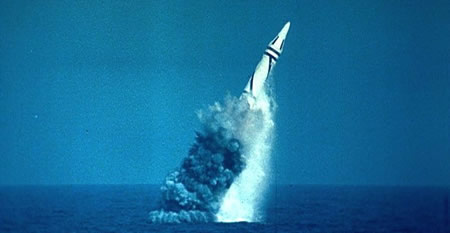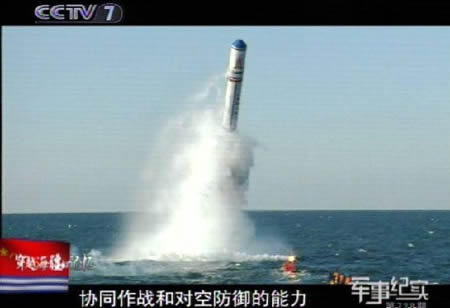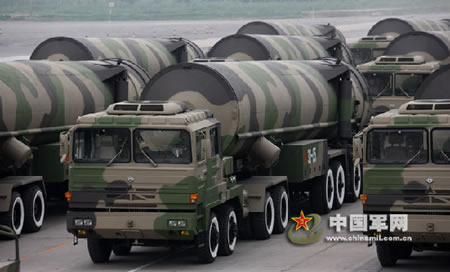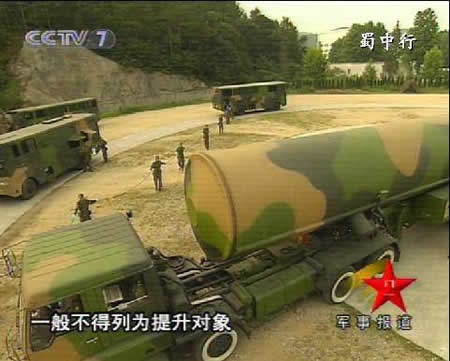 |
.
By Hans M. Kristensen
Similar to Russia’s troubled Bulava sea-launched ballistic missile, the Pentagon’s latest report on China’s military power reveals that Chinese efforts to develop a new sea-based nuclear missile have run into problems.
Other nuclear force developments described in the Pentagon’s delayed annual report on China’s military power, now renamed Military and Security Developments Involving the People’s Republic of China, include a slow deployment of new land-based mobile missiles and nuclear command and control challenges.
Naval Nuclear Programs
While the first boat of a small class of new Jin-class (Type 094) sea-launched ballistic missile submarines “appears ready” and up to four more may be building, development of the long-range ballistic missile Julang-2 for the class is said to have “encountered difficulty.”
The report reveals that the new missile has been “failing several of what should have been the final round of flight tests.”
| Julang-2 “Dry” Launch |
 |
| The Pentagon says China’s new sea-launched ballistic missile has failed several tests. |
.
The latest setback continues the problems that have characterized China’s naval nuclear program over the years. The first SSBN program (Type 092) only produced one boat, the Xia, which has never sailed on a deterrent patrol. Even following a recent lengthy submarine overhaul, the Pentagon describes the operational status of the Xia’s Julang-1 missile system as “questionable.”
The nuclear-powered attack submarine program also seems challenged, with only two Shang-class (Type 093) boats operational – the same as last year – and four old Han-class (Type 091) boats still in service. Instead, the focus of the nuclear attack submarine program appears to have shifted to building a new class, the Type 095. The Pentagon report projects that “up to five” Type 095s may be added “in the coming years.”
Land-Based Nuclear Missiles
Introduction of new land-based mobile ballistic missiles continues, but at a slow pace. The DF-31 program appears stagnant at “<10” missiles, the same as reported last year. The number of intercontinental DF-31As has only increased by a couple of missiles, from “<10” last year to “10-15” in this year’s report.
| DF-31A Parading in Beijing |
 |
| Deployment of the DF-31 and DF-31A has been slow, new Pentagon report shows. |
.
Probably as a possible result of the slow deployment of the new DF-31, the number of old liquid-fueled DF-3A and DF-4 missiles remain the same as last year.
Despite a strong display at the military parade in Beijing last year, the number of DF-21 launchers has not increased compared with last year. The number of missiles is a little higher, 85-90 missiles versus 60-80, probably reflecting addition of conventional DF-21C versions.
The report continues previous years’ predictions that a new road-mobile ICBM may be under development, possibly a reference to the elusive DF-41 or another system. The new missile is described as “possibly capable of carrying a multiple independently targeted re-entry vehicle (MIRV).”
Previous reports have reported development of MIRV technology for many years, but always concluded that MIRV technology for mobile missiles would be too difficult and expensive. The reference to a road-mobile ICBM MIRV capability is new, although it comes with a lot of caveats: “may be under development,” and “possibly capable of carrying” MIRV.
A MIRV system would, if deployed, represent a significant change in Chinese nuclear employment strategy. Russia and the United States deployed MIRVed systems to improve targeting against military targets. A secondary reason – for Britain it was probably the primary reason – was to overwhelm missile defenses.
Rather than increased targeting, the Chinese motivation for pursuing MIRV probably is the emergence of increasingly advanced U.S. ballistic missile systems. Phase 4 of the Obama administration’s Phased Adaptive Approach (PAA) includes an anti-ballistic missile defense capability against ICBMs from around 2020. This may push China further toward MIRV.
| Julang-1 Loading |
 |
| Could loading of nuclear missiles in a crisis affect crisis stability? |
Nuclear Command and Control
As were the case with the 2009 report, the 2010 report underscores the command and control issues facing Chinese leaders. “The introduction of more mobile systems will create new command and control challenges for China’s leadership, which now confronts a different set of variables related to deployment and release authorities.”
One of these is the emerging SSBN force, an almost entirely new form of nuclear deployment in Chinese posturing. The report states that “the PLA has only a limited capacity to communicate with submarines at sea, and the PLA Navy has no experience in managing a SSBN fleet that performs strategic patrols with live nuclear warheads mated to missiles.”
Chinese SSBNs have never performed a strategic deterrent patrol (none were conducted in 2009), and if current Chinese doctrine is any indication it is doubtful that the SSBNs will deploy with “live nuclear warheads mated to missiles” in peacetime. But the absence of operational experience and the limited communication capability raises serious questions about how inadequate proficiency and launch control procedures might create problems in a crisis.
The report raises similar issues with the emergency of the new generation of land-based mobile missiles. Although China has operated medium-range mobile missiles for decades, the delegation of launch authority in a crisis to units with quicker-launch solid-fuel long-range missiles raises questions about use control, crisis stability, and misunderstandings.
| DF-31A on Launch Pad |
 |
| How will quicker-firing long-range missiles such as the DF-31A affect command and control and delegation of launch authority? |
.
And there “is little evidence,” the Pentagon concludes, “that China’s military and civilian leaders have fully thought through the global and systemic effects that would be associated with the employment of these strategic capabilities.”
Despite these issues and speculations in previous annual Pentagon reports and the public about possible changes to Chinese nuclear doctrine, particularly conditions to its no-first-use policy, the 2010 report concludes that, “there has been no indication that national leaders are willing to attach such nuances and caveats to China’s ‘no first use’ doctrine.”
See also: previous blogs about China
This publication was made possible by a grant from Carnegie Corporation of New York and Ploughshares Fund. The statements made and views expressed are solely the responsibility of the author.
While advanced Chinese language proficiency and cultural familiarity remain irreplaceable skills, they are neither necessary nor sufficient for successful open-source analysis on China’s nuclear forces.
Satellite imagery has long served as a tool for observing on-the-ground activity worldwide, and offers especially valuable insights into the operation, development, and physical features related to nuclear technology.
This report outlines a framework relying on “Cooperative Technical Means” for effective arms control verification based on remote sensing, avoiding on-site inspections but maintaining a level of transparency that allows for immediate detection of changes in nuclear posture or a significant build-up above agreed limits.
The grant comes from the Carnegie Corporation of New York (CCNY) to investigate, alongside The British American Security Information Council (BASIC), the associated impact on nuclear stability.